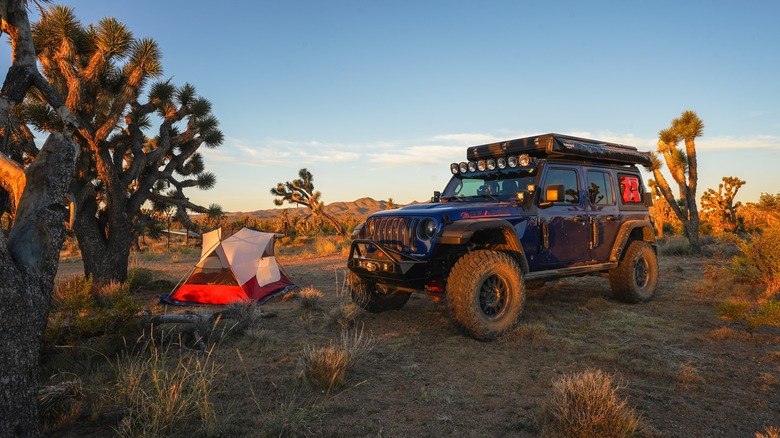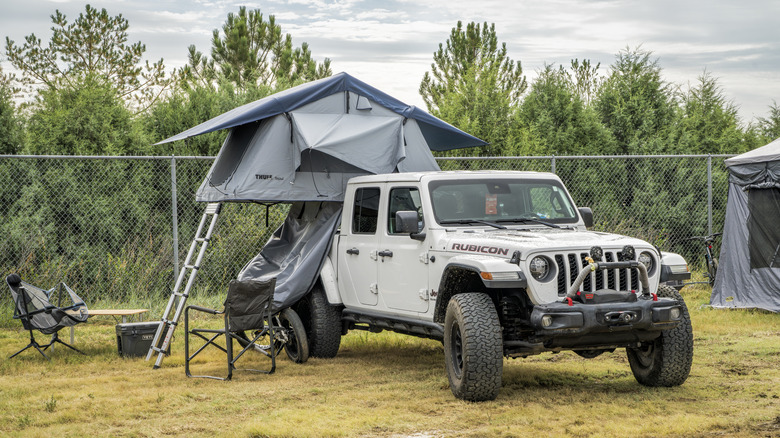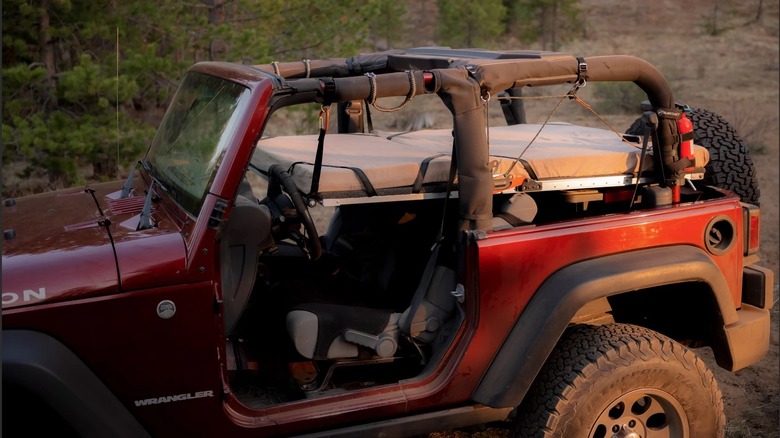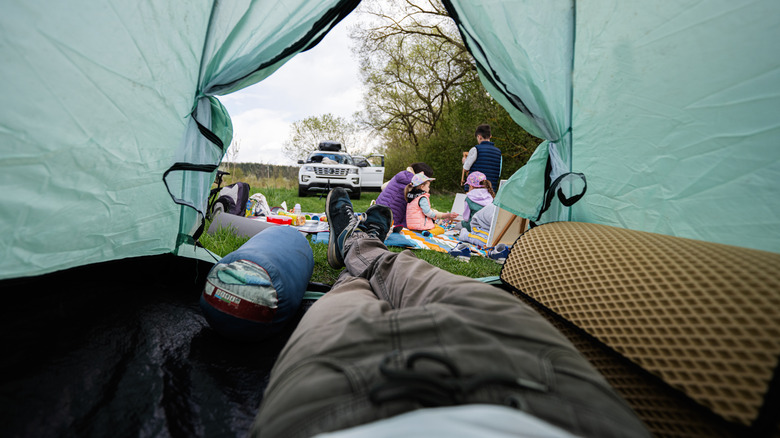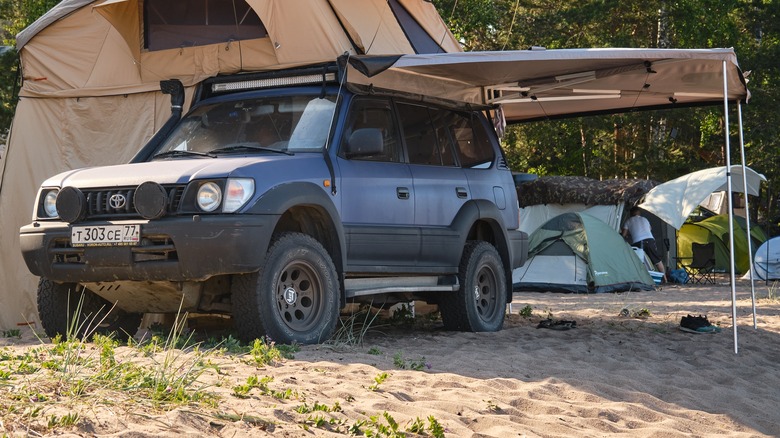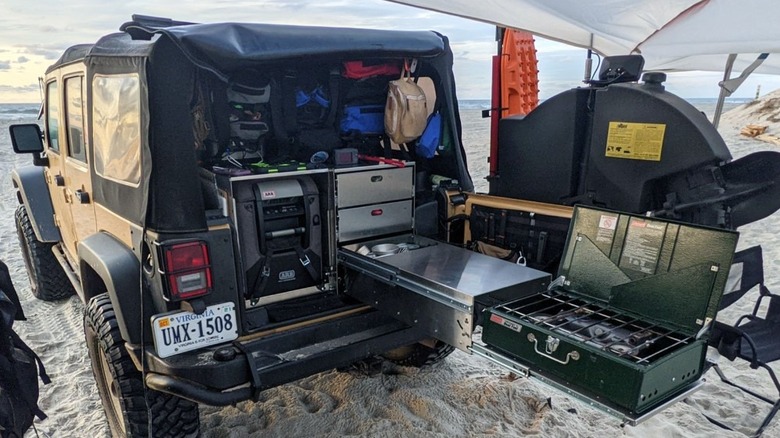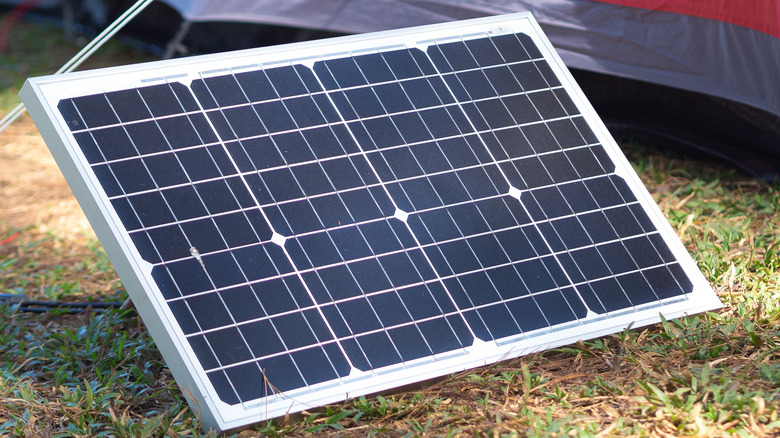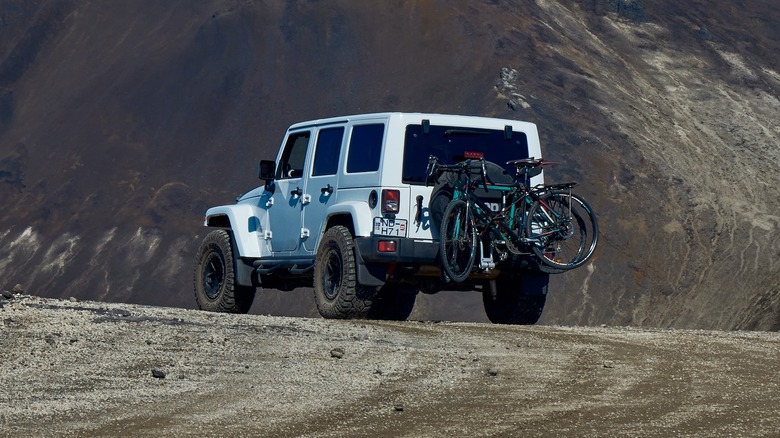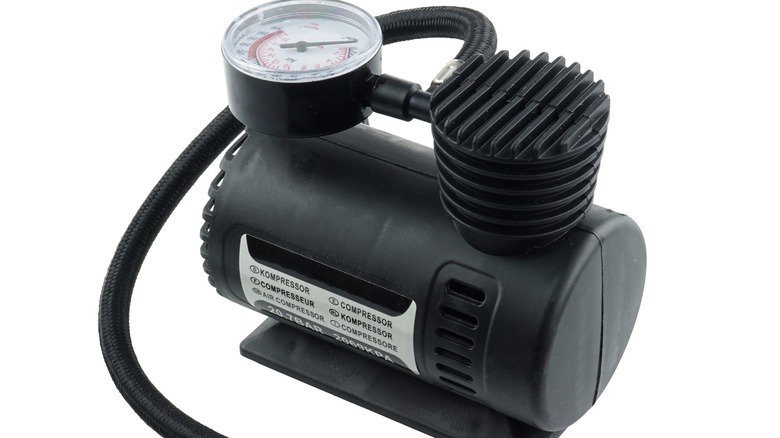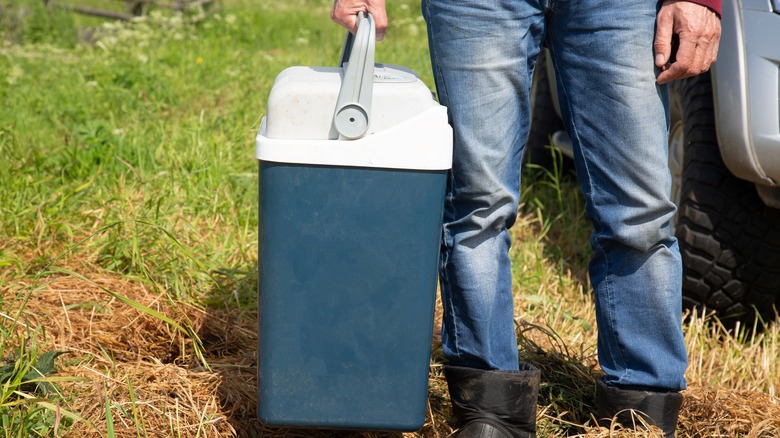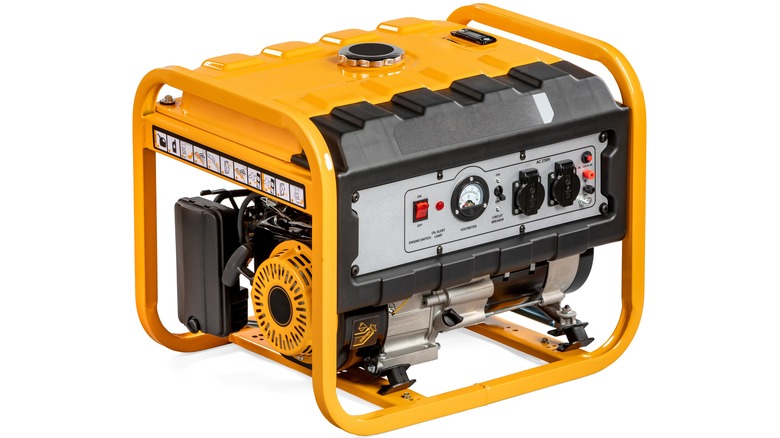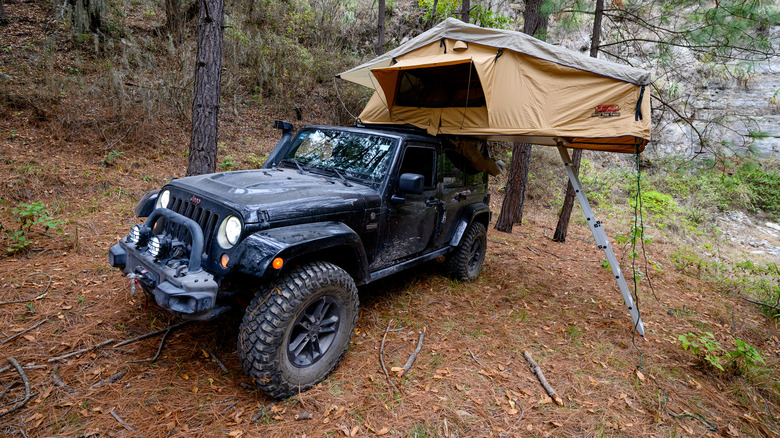10 Jeep Accessories For Your Next Camping Trip
Jeep's rugged, go-anywhere attitude has been in the making since the original Willys MB hit the battlefields of Europe in the 1940s. Valued for its durability and modularity, the Jeep nameplate has come a long way from its first mission, ferrying GIs to victory. However, Jeep's trajectory changed in 1987 when Chrysler acquired the brand at Lee Iacocca's urging. Introducing the first Jeep to bear the Wrangler nameplate set the brand toward stability. Since then, Jeep has become synonymous with overlanding adventure and off-road performance.
Today, striking into the wilderness behind the wheel of a Jeep is a beloved pastime for millions. Whether modified or bone stock, the Wrangler is a great camping and trail-driving platform. Fortunately for hobbyists, an enormous market for accessories makes the Jeep an excellent platform for escaping from society for a few days or weeks at a time. In the spirit of adventure, we look at ten Jeep accessories to set your next outdoor adventure up for comfort and success.
Rooftop tent
One of the major challenges of a camping adventure is sleeping on the ground. Curious animals and protruding roots can dampen your outdoor experience. In response to this, aftermarket camping companies have introduced a line of Jeep rooftop tents.
Rooftop tents attach to the top of your Jeep, giving you a place to sleep up and away from the ground. Other benefits include not needing to store your tent inside the cargo area, leaving more room for people or supplies, and generally being easy and quick to pitch once you get to the campsite. When considering a rooftop tent, compatibility with the vehicle should be the priority followed by size, ease of setup, and capacity. Hard-shell rooftop campers tend to have less room and more weight than softshell campers.
The tradeoff of the extra weight is better durability. Storms don't wait for you to get home to strike, and a windy thunderstorm in a softshell tent six feet off the ground may not be the experience you envisioned. On the other hand, softshell tents tend to be less expensive and capable of housing more people. Consider how you plan to camp before investing in a rooftop tent. If road trips from your campsite constitute a significant part of your itinerary, a rooftop tent may not be for you, as using the vehicle necessitates taking down the tent. However, if you stay stationary, a rooftop rig may be up your alley.
Micro RV hanging bed by Oryx
The four-door Wrangler has become a popular camping platform. The added storage space and rider capacity provide opportunities the two-door just doesn't. However, the shorter wheelbase and lower weight of the two-door models may be what you've got in the garage or what performs better on the narrow trails of the area.
The Hanging Bed by Oryx turns the two-door Wrangler into a sleeping platform with just a few steps. Oryx's founders sought a solution after becoming frustrated with the investment and setup required of rooftop tents. Using their Jeep's roll cage as the foundation, Oryx developed a sleeping platform for two-door Wranglers that turns the cab into a sleep station.
Users must remove the rear seats before attaching the Oryx sleep platform to the roll cage with carabiners. A foam mattress goes over the platform, creating a sleep and rest spot that unfolds when it's time to sleep. If you wish, you can leave the top off for stargazing, but there is enough room to install the sleeping platform with the roof on.
Tailgate tent
Maybe clambering up and down a ladder in the middle of the night to go to the bathroom isn't your idea of a fun time, or you need the storage options your rooftop rack provides. In either case, a tailgate tent is another option for tenting in a Jeep that you might consider.
Some tailgate tents can be directly attached to the vehicle, providing a comfortable sleeping space without the need for a ladder. Others function more like traditional ground tents, but with the added benefit of easy access to the rear of the Jeep. This versatility makes them a great choice for various camping situations, especially in inclement weather when you need access to gear and power outlets without leaving the shelter.
Some rooftop tents include foldout sections that increase space inside, but most are limited to the vehicle's footprint. In contrast, ground tents can be positively palatial, as the size of the campsite is the only limit. Aside from floor space, the ground tents tend to be much taller than rooftops, giving people more room to move around and get dressed in the privacy of their shelter.
One of the most compelling reasons to consider a tailgate tent is its affordability. Unlike rooftop tents that can cost $1,000 to $3,000 or more, tailgate tents are a much more budget-friendly option, with highly rated models available at a fraction of the price.
Portable awning
Sometimes a rain squall or thunderstorm hits even when the weather app says it's supposed to be clear, and not everyone wants to hunker down in their tent during those times. Thankfully, Jeeps also come with various attachable awnings that protect from wet weather.
Awnings are a benefit usually reserved for those invested in a full-sized camper. They conveniently roll out, setting up in mere minutes when needed. Some awnings, like the Rhino Batwing (compatible with Rhino roof rack systems only), cut 90 degrees, creating two distinct areas around nearly half the vehicle. Others unfold into full collapsible rooms. Theoretically, one could traverse from a tailgate tent into a dining or changing area without leaving the shelter.
Most awnings only work with a roof rack, and some may require drilling holes for installation. Getting one that is compatible not just with a Jeep but also with the specific roof rack setup of your Jeep is paramount. However, once that initial installation is finished, it should take just a few minutes to unfurl it at your destination.
Trail kitchen
Cooking outdoors can be frustrating and rudimentary. After a long day on the trail, the last thing you want to do is spend an hour locating and unpacking your cooking kit. Luckily, high-tech gadgets can help make it much easier. Incorporating a trail kitchen means saving time to enjoy the great outdoors and not relying on campsite infrastructure to rustle up quality grub.
A trail kitchen can be anything from a container and a cooler to a fully expandable gourmand's workstation. After perfecting his setup, Al Smith founded Jeep Kitchen, now rebranded as Overland Kitchen. Al now makes setups for multiple rigs, but the original came from a Wrangler. Campers can set up an entire kitchen using telescoping stainless steel cabinetry extending from the vehicle's rear gate within minutes. One downside to this setup is that the installation takes a significant amount of cargo room, but not every trail kitchen does needs to be a semi-permanent installation.
A good trail kitchen may be a container filled with your preferred setup. The best camp stoves on the market are light, durable, functional, and can be surprisingly space-efficient. You can also split the difference with a quick-to-unpack trail kitchen kit like this one from Rhino Adventure Gear.
Solar panels
It seems energy needs increase every year. With every gadget and gizmo requiring regular recharging, finding that all-important electrical outlet on the go is more important than ever. Whether you want to scroll Instagram from the hammock, boot up the satellite phone to call for help, or simply charge up the speaker for some woodland jams, a portable solar panel brings power to even the deepest wilderness.
While it's up for debate whether residential and commercial solar panels are worth the cost, camping is a perfect application of solar technology. Deciding which wattage will work best depends on your energy needs. Charging a few phones is a far cry from keeping a refrigerator running, so check the product labels of all the devices you wish to replenish during a trip to find their amperage requirements. Determine how much solar panel wattage you'll need, then add 20%. Having power and not needing it is infinitely preferential to needing it and not having it.
Some solar panels come in portable kits you can set up in a few minutes, while others can be installed on the roof or hood of a Jeep and hardwired into a complete electronic system.
Bike racks
Whether electric or old-fashioned pedal-powered, bicycles are a great way to get around a camping area, especially if you've set up your rooftop tent or awning and that Jeep isn't going anywhere. Depending on how the Jeep is loaded, a rear-mounted bike rack may be just the way to transport your bicycles with minimum hassle, primarily if the roof is already spoken for with a tent or storage container. Most rear-mounted racks extend from the trailer hitch, clearing the spare tire with arms for attaching bicycles.
All-terrain e-bikes, such as these from QuietKat, are a versatile option for camping. They offer a long-range and operate quietly, allowing you to explore the camping area without the need to dismantle your camp. Even if you prefer the simplicity and weight savings of pedal bikes, a quality bike rack for the back of your Jeep is a smart investment. It saves interior storage space, doesn't interfere with rooftop tents, and is easy to use. Some racks can even carry up to five bikes, serving to the whole family.
Air compressor
Keeping an air compressor on hand on the trail can mean the difference between being stranded and motoring your way out of the trail. Beyond that, using a compressor sure beats manually blowing up a river tube or using a manual pump to inflate a kayak. They can be convenient for camping that involves significant off-roading, as changing the air pressure in tires can help navigate tricky routes. Large enough compressors can also power pneumatic tools in case of a breakdown.
Portable air compressors are divided into two main categories: piston and rotary. Rotary compressors use adjustable vanes by spinning to suck air in and then transferring it to ever-smaller chambers, thus compressing it. They operate at much cooler temperatures than piston compressors as they experience less friction. Piston compressors operate by pulling in air and compressing it with a pump before transferring it to a storage container. They have a larger number of working parts, tend to be bulkier, and weigh more than rotaries.
Portable compressors can be powered by fuel or electrically. Hooking one up to the Jeep battery is possible, but beware that draining down the battery could result in being stranded. On the other hand, carrying extra fuel can be burdensome and not the vision you have for your simple weekend in the woods.
Portable refrigerator
Keeping food cold and fresh on the road can be a tall order. Striking out into the wilderness seldom guarantees a fresh place to buy ice, and not everyone wants to haul a cooler around or deal with it if it tips and leaks. If the full trail kitchen setup isn't for you, consider checking out a refrigerator designed for your Jeep.
A 12-volt compression refrigerator may be pricier than other options, but it represents the best of all worlds. It can run off the Jeep when the engine is running and continue off the car's battery, but it will shut off before draining it. Hooking it up to a solar panel or generator is also possible.
Some manufacturers have designed slide-out accessories similar to the trail kitchen mentioned earlier. These accessories make it easy to pull the refrigerator out of the back of the Jeep. Other models are designed to be easily transportable, making it a breeze to move them to wherever you need a cold drink or ingredients for the grill.
When deciding which compression fridge to purchase, it's important to consider a few key factors. The duration of your trip should be a primary consideration, as it will determine the size and capacity of the fridge. Additionally, portability and power drain are important. If you tend to set up your food station away from the vehicle, you'll want to avoid hauling a heavy fridge a long distance after a day of hiking.
Portable generator
There are many things on this list that require power. Using the Jeep battery or sunshine may not be enough to keep them all going. A portable, gas-powered generator should give you all the power you need.
Generators can be noisy and usually run on internal combustion, meaning exhaust fumes would be present in your campsite. While a solar panel might serve the camping aesthetic better, a generator for emergencies is excellent to have on hand. Since they run on gasoline, carrying an extra fuel supply is necessary (unless you're a fan of siphoning), which can be heavy and smelly. Battery-powered generators are much quieter than gasoline-powered generators but tend to be tied to the battery's life, after which they are kaput.
A small generator, typically between 300 and 3600 Wh, offers you the freedom to venture beyond the traditional campsites. It provides built-in power, enabling you to operate your cooking, entertainment, or emergency devices whenever the need arises, allowing you to camp in safety and comfort.
How we selected these accessories
Some of the items on this list may not fit into your camping lifestyle, but after all, everyone likes to enjoy their vacation in their own way. We developed this list by examining common camping needs, researching consumer guides and reviews, and choosing a set of the minimum items that make the maximum impact on the quality of a camping trip. As avid campers, we feel that any combination of the above mentioned items will help make a safe, comfortable camping trip even better!
